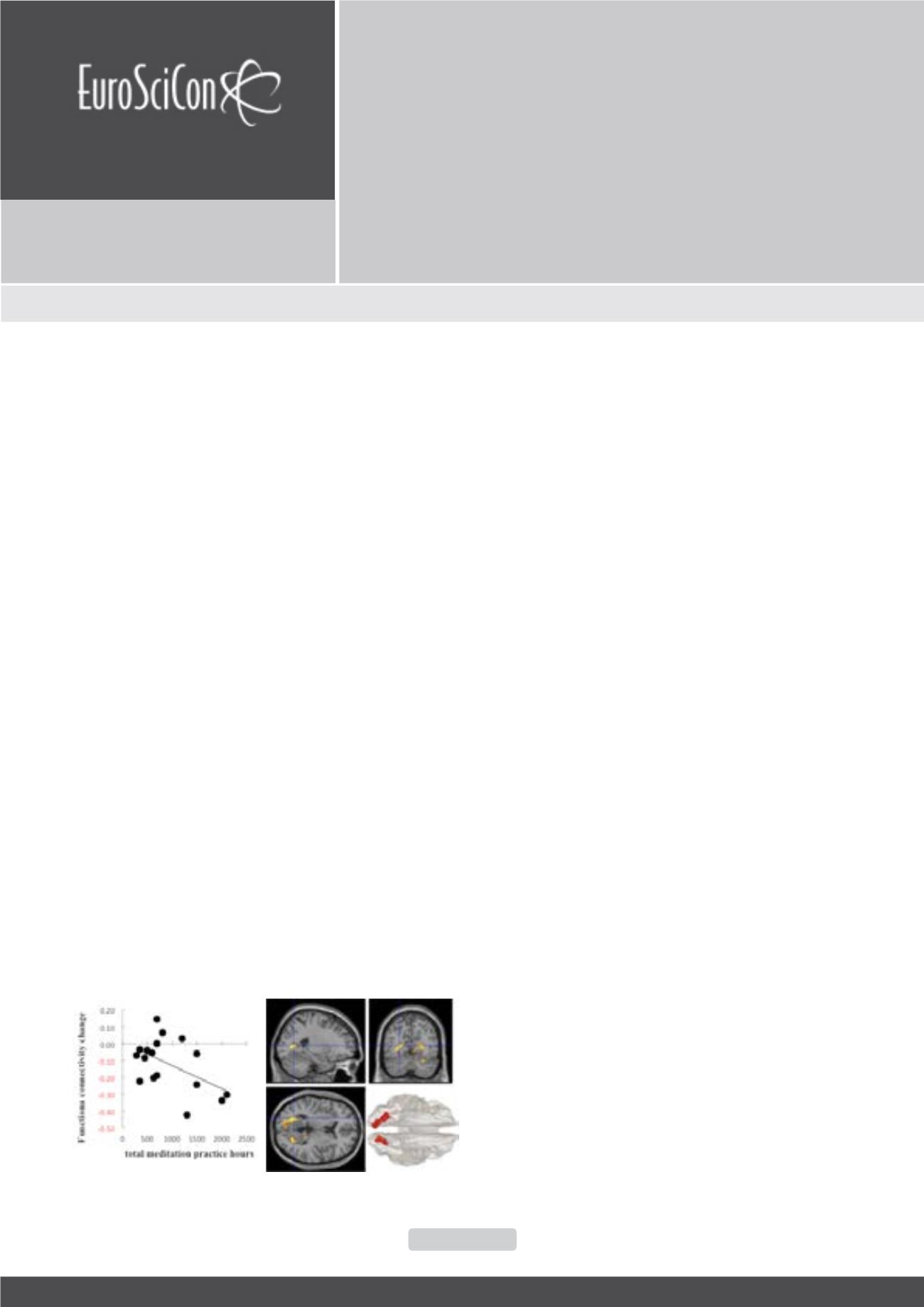

Addiction Psychiatry 2018
Journal of Addiction Research & Therapy
ISSN: 2155-6105
Page 24
August 13-14, 2018
Madrid, Spain
8
th
International Conference on
Addiction Psychiatry
T
ranscranial direct current stimulation (tDCS) can modulate
mind wandering, which is a shift in the contents of
thought away from an ongoing task and/or from events in the
external environment to self-generated thoughts and feelings.
Using functional magnetic resonance imaging (fMRI), we
investigated the causal relationships among tDCS, stimulation-
induced directed connection alterations within the DMN,
and is part of the default mode network (DMN) that enables
modulation of the internal mind wandering, perhaps facilitating
rumination about drug use in addicted participants. The anodal
tDCS on the right inferior parietal lobule (IPL) decreased the
afferent connections of the posterior cingulate cortex (PCC)
from the right IPL and the medial prefrontal cortex (mPFC).
Furthermore, mediation analysis revealed that the changes in
the connections from the right IPL and mPFC correlated with
the facilitation and inhibition of mind wandering, respectively.
These effects are the result of the heterogeneous function
of effective connectivity: the connection from the right IPL
to the PCC inhibits mind wandering, whereas the connection
from the mPFC to the PCC facilitates mind-wandering. Then
the author will present the function of different styles of
meditation, focused attention meditation (FA) and open
monitoring meditation (OM). We found that FA and OM are
associated with different functional connectivity between the
striatum and DMN regions. Finally, the author will summarize
the emerging body of knowledge that suggests the benefits
of mindfulness meditation on treating addiction, and different
types of meditation exercises.
Figure 1: Relative to beginners, experienced meditators may be more free from their
autobiographical memory.
Recent Publications
1. Fujino M, Ueda Y, Mizuhara H, Saiki J and Nomura
M (2018) Open monitoring meditation reduces the
involvement of brain regions related to memory function.
Scientific Reports 8.
2. Takano R and Nomura M (2018) Anodal transcranial
direct current stimulation of the right temporoparietal
junction enhances the self-effacing bias in Japanese
individuals. Culture and Brain DOI: 10.1007/s40167-018-
0064-4.
3. Kajimura S, Kochiyama T, Abe N and Nomura M (2018)
Challenge to unity: Relationship between hemispheric
asymmetry of the default mode network and mind
wandering. Cerebral Cortex DOI: 10.1093/cercor/bhy086.
4. Yanagisawa K, Kashima E S, Moriya H, Masui K, Furutani
K, Yoshida H, Ura M and Nomura M (2017) Tolerating
dissimilar other when primedwith death: Neural evidence
of self-control engaged by interdependent people in
Japan. Social Cognitive and Affective Neuroscience
12:910–917.
5. Kajimura S, Kochiyama T, Nakai R, Abe N and Nomura M
(2016) Causal relationshipbetween effective connectivity
within the default mode network and mind-wandering
regulation and facilitation. Neuroimage 133:21-30.
Biography
Michio Nomura, PhD is an Associate Professor at the Kyoto University.
He graduated from the Faculty of Technology at the Nagoya University.
He contributed to the identified neural mechanisms of processing
subliminally presented emotional stimuli with fMRI (functional magnetic
resonance imaging) when he was a graduate student at Nagoya
University. He began research on the molecular mechanisms of the brain
reward system, including serotonergic systems, at Nagoya University in
2002 and continued this research at Hiroshima University (2008-2010)
and the Kyoto University (2010-present). He has served as an Executive
Member of the Japanese Society of Neuropsychopharmacology (JSNP)
since 2009. He was awarded the Japanese Brain Science Society Young
Investigator Award in 2007, the CINP Presentation Award from the JSNP
in 2010, and 2011. He serves as Academic Editor of several journals,
Frontiers in Psychology and Interdisciplinary Education and Psychology.
nomura.michio.8u@kyoto-u.ac.jpReducing mind-wandering with transcranial direct current
stimulation and mindfulness meditation
Michio Nomura
Kyoto University, Japan
Michio Nomura, J Addict Res Ther 2018, Volume 9
DOI: 10.4172/2155-6105-C2-039
















